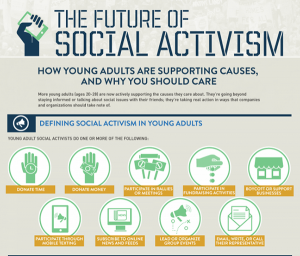I happen to follow several different organizations on social media websites. Why I follow them? To stay on top of new promotions they provide (reason for following airline companies), to stay on top of news about them (reason for following favorite shows), to get access to content they provide (good for favorite movies/shows and news/blogs) or to be able to access them if I need to say something (products I have).
Companies that know how to use social media do it in a way that doesn’t overpower their followers’ timelines (the case for those in Facebook and Twitter), and I’ll keep following them. If they prove too intrusive (many posts a day, posts I don’t care for), I’ll stop following them.
Chances are if I follow the company I already care for their products and what they have to say to me will be interesting enough for me to keep on following them. But, sometimes, things backfire and seeing stuff I don’t care so much about annoys me. I tend to participate in calls-to-action if they interest me, as in, sending pictures in reply to prompts, commenting on a favorite thing, pitching in with ideas when requested and, of course, contacting them when something is not to my liking.
I’ve found, and many others have too, that complaining through social media is the fastest way to get an answer from a company. I usually try to find chat areas in websites to complain about something and get fast answers, my second tool of choice is email, and my third is social media. Social media is faster, in most cases, but it really puts the issue “out there” so I have to be really angry to use it as a first recourse. From the corporate side of things, monitoring social media for customer problem interactions is a smart way to turn a dissatisfied customer into a brand advocate. Resolving something fast and showing proactiveness can really turn the tables on a disgruntled customer.
As far was why social media is important to corporate entities I can say the key word is “two-way” communication and relevance. It allows them to build knowledge about their consumer base, bounce ideas off them, get feedback and position themselves are trusted sources of knowledge. By providing interesting information that is relevant to their customers’ interests they are able to build a relationship that wasn’t there before social media came along.
Harvard Business Review has some interesting insights into social media use by corporations: “Social media has arrived, but companies still aren’t sure what to do with it. Fifty-eight percent of companies are currently engaged in social networks like Facebook, microblogs like Twitter, and sharing multimedia on platforms such as YouTube – but research from the Harvard Business Review Analytics Services report “The New Conversation: Taking Social Media from Talk to Action” finds that much of the investment in social is future-oriented.” Several takes from this research are illustrating this post.
Social Media activism is also on the rise, cue in the ALS challenge data: “As of Monday, August 18, 2014 the ALS Association has received $15.6 million in donations compared to $1.8 million during the same time period last year (July 29 to August 18); these donations have come from existing donors and 307,598 new donors to The Association.” In fact it’s been important for quite some time (Arab Spring, Kony, Bring Back our Girls, etc), just click on the name inside the brackets to see articles referring to these campaigns and their results.
Personally I’m a bit skeptical about using social media as the only strategy for an activism campaign, if you are lucky (and smart) you’ll be able to gain traction fact, maybe even raise some money, but will this last. Will it effectively lead to a permanent change in people’s behaviors and minds, will it keep you on the radar or will your fame only last until the next big thing comes along? Online activism has the big plus of people being able to join in from the comfort of their own homes, usually wearing their pajamas and sipping a warm latte. It makes them feel purposeful, like they really accomplished something and “see it wasn’t all that hard”. Activism the old way, running from the cops and being hosed down in front of a presidential palace was way harder, not to mention sitting down without food or a comfortable bed to sleep on for days protesting against the war or someone’s arrest. It was harder but it required a level of commitment to the cause that was sure to last past a wet cold night. Maybe I’m just to old and doubt the ability of clicking my way through true societal change. For me change requires more than clicks and shares, it requires creating the kind of physical unrest that shows commitment.
Social media is a great complimentary strategy to activism but if it’s its only arena of expression I’m sure whatever is achieved will not guarantee continued involvement with the cause. Having said this, the money ALS received is bound to make a difference for them, and if it doesn’t happen again next year it still is money in the bank for them today.
Sources: http://hbr.org/web/slideshows/social-media-what-most-companies-dont-know/1-slide
http://www.alsa.org/news/media/press-releases/ice-bucket-challenge-0818.html






